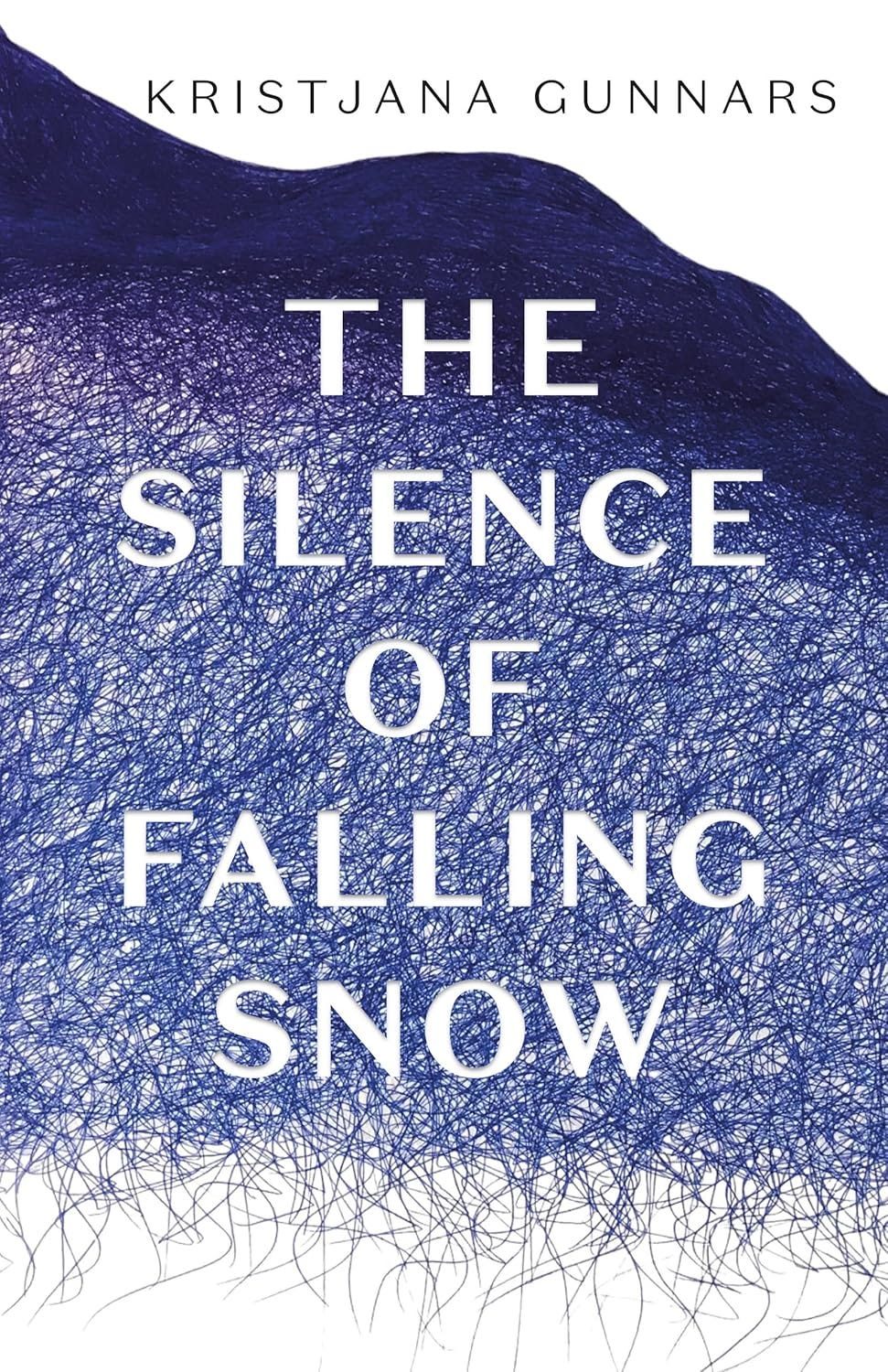Buddhist Bricolage: The Silence of Falling Snow by Kristjana Gunnars
Reviewed by Michael Greenstein
Kristjana Gunnars’ ink on paper drawing, “scree,” forms the cover art for her memoir, The Silence of Falling Snow. Her blue filaments descend to rhizomes of the subconscious that resonate through the twenty-five parts of her book that are further subdivided into sections separated by a snowflake design, an elaborate asterisk that falls silently across each page. The epigraph to “Part One” from the journals of a Norwegian fig tree grower serves as an apt transition between “scree” cover and the text that follows: “I bought the seed of a fig tree and planted it. Soon it began to sprout and grow so I bought several more seeds and planted them.” These sentences point to the dis-location of the fig tree in a Nordic climate, as well as its proliferation that parallels Gunnars’ multiple associations through her time of grieving for her dying husband. Gunnar composes her prose through the silence of Buddhist paths branching from Tibet to Norway, crisscrossing time, place, mood, and texts of wisdom. Her scree tumbles in silence and contrasts with Edvard Munch’s The Scream, which recurs in her book.
“Gunnar composes her prose through the silence of Buddhist paths branching from Tibet to Norway, crisscrossing time, place, mood, and texts of wisdom.”
She begins with various beginnings and proliferations: “Three vehicles,” “Three thousand realms,” and “Ten thousand things.” In other words, Gunnars accumulates associations to fill in her story about accompanying her husband to his death though gates of perception and emotion; or her story may be about a white butterfly accompanying her on her journey. “You do not know where the butterfly is headed or what it is saying, or why it is flying in such an irregular way.” She walks and flies together across genres, texts, and landscapes, scree and snowflake falling into place.
As one story leads to another, her butterfly drifts to Buddhism: “I am reminded of a story in the Pali Sutras in the foundational text of Buddhism” about a dog on a leash that goes around in circles. Gunnars circles her subject and story, shaping it in various patterns. Butterfly and dog may morph into a raft in the flow of associations: “Imagine a raft on a river…. That raft is your whole life.” Gunnars’ story is also Gautama Buddha’s story, and these stories progress slowly and soundlessly toward a dawning sensation of “non-knowing” and small turns: “There could be no big fixes, only piecemeal engineering.” In other words, a collage of bricolage – the bits and pieces of scree, snowflake, thread, emotion, and perception. The bricoleur or bricoleuse engages also in the Japanese process of kintsugi wherein a broken vessel is glued together with gold filling. “The bowl will stay broken for a long time, in a pile of ceramic pieces, before it will be put back together.” Bowl and soul require considerable waiting time for healing. This waiting time shifts from hold to “behold,” as in a mosaic of a Roman cathedral. “The broken pieces are rearranged to show the sun like a red fan blistering above a procession of supplicants in blue clothing, making their way toward a giant bubble of cyan-blue sky filled with stars.” Gunnars’ grieving is a post-traumatic pilgrimage that takes its own time.
Another part of healing may involve a medicine bundle or spiritual bricolage. “In Canada I have so often encountered the medicine bundle: a rawhide pouch, sometimes with beads, containing herbs and grasses Indigenous people in the Plains carried with them.” Storytelling may also be a medicine bundle, a collection of healing events, as in Ursula Le Guin’s essay on “The Carrier Bag Theory of Fiction,” linked in the etymologies of care, cure, and curate. The synaesthetic narrator moves from Buddhist stories to the collage canvases of Vassily Kandinsky “who once said that white is the colour of silence.” Gunnars’ prose circles, arcs, triangles, and shape-shifts through The Silence of Falling Snow, her “anti-memoir” or detour from any fixed path.
She quotes from Jacques Derrida’s Memoirs of the Blind: The Self-Portrait and Other Ruins, which compares drawing to surgery. This leads to a consideration of the Book of Tobit, as Gunnars continues to write asymmetrically and spontaneously in multiple directions. Whereas the Egyptian author Edmond Jabès writes a book of sand, she writes her book of snow containing birds, tigers, foxes, and other species. In her soundscape of silence and scent of light she strikes a singing bowl for companionship to unite Tibet and Iceland in Buddhism and the Land of Snows.
About the Author
Kristjana Gunnars was born in Iceland and has lived in Canada since 1969. She served as Professor of English and Film Studies at the University of Alberta, and as Guest Professor at the University of Trier in Germany and the University of Iceland. She lived on the Sunshine Coast of British Columbia for twenty years while pursuing a career in the arts (painting), as well as writing. She is the author of numerous books (see websiteskristjanagunnars.com and kristjanagunnarswritings.com for details). Her latest books are The Scent of Light (Coach House, Toronto) and Ruins of the Heart (Angelico, New York).
About the Reviewer
Michael Greenstein is a retired professor of English (Université de Sherbrooke). He is the author of Third Solitudes: Tradition and Discontinuity in Jewish-Canadian Literature and has published widely on Victorian, Canadian, and American-Jewish literature.
He has published 250 essays and reviews in books and journals across Canada, the United States, and Europe.
Book Details
Publisher : Coach House Books
Publication date : Sept. 23 2025
Language : English
Print length : 240 pages
ISBN-10 : 1552455084
ISBN-13 : 978-1552455081



